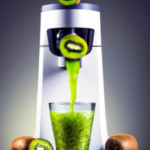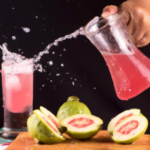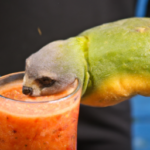I absolutely love dragon fruit juice – it’s refreshing, delicious, and packed with important nutrients! In this article, I will take you step by step through making your own dragon fruit juice at home.
First, we’ll talk about the benefits of dragon fruit and how to choose the right fruit at the store. Then, we’ll go through the steps of preparing and blending the fruit, including how to strain the juice and add sweeteners if desired.
Dragon fruit is an excellent source of vitamins, antioxidants, and fiber. It’s also low in calories and has been shown to help regulate blood sugar levels. Plus, it’s just plain tasty!
But choosing the right dragon fruit at the store can be a bit tricky, so I’ll give you some tips on what to look for. Once you have your fruit, we’ll get started on making the juice. Trust me, it’s easier than you think!
So let’s get started and make some delicious dragon fruit juice together.
Key Takeaways
- Choose the right dragon fruit variety at the store.
- Wash, peel, and cut the fruit into small pieces before blending and straining it.
- Use natural sweeteners like honey or agave instead of artificial sweeteners.
- Store the dragon fruit juice in an airtight container in the refrigerator or frozen as cubes to extend its shelf life.
Benefits of Dragon Fruit
You’re going to love the benefits of dragon fruit – it’s packed with antioxidants, fiber, and vitamins that nourish your body and boost your overall health! The nutritional value of dragon fruit is impressive, as it contains multiple essential nutrients.
Dragon fruit is a great source of vitamin C, which helps boost your immune system. It’s also rich in fiber, which aids in digestion and helps regulate blood sugar levels.
In addition, dragon fruit is low in calories and high in antioxidants, which can help reduce the risk of chronic diseases such as heart disease and cancer. The health benefits of dragon fruit are numerous, and incorporating it into your diet can help improve your overall health and well-being.
Now, let’s move on to choosing the right dragon fruit.
Choosing the Right Dragon Fruit
When picking out the right dragon fruit, it’s important to look for ones with a vibrant, evenly colored exterior and a slightly soft texture when squeezed gently. Dragon fruit comes in three different varieties: white-fleshed, red-fleshed, and yellow-fleshed. Each variety has its own distinct taste and texture, with the white-fleshed variety being the sweetest and the red-fleshed variety having a more tart flavor. Here are some selecting tips to keep in mind when choosing your dragon fruit:
| Selecting Tips | White-Fleshed | Red-Fleshed | Yellow-Fleshed |
|---|---|---|---|
| Exterior Color | Bright pink/red with green tips | Dark red with green tips | Bright yellow with green tips |
| Flesh Texture | Soft and juicy | Firm and slightly crunchy | Soft and slightly juicy |
| Flavor Profile | Sweet with a hint of sourness | Tart with a hint of sweetness | Mild with a hint of sweetness |
With these tips in mind, you can choose the perfect dragon fruit for your juice recipe. Now that we have selected our dragon fruit, let’s move on to preparing the fruit for juicing.
Preparing the Fruit
To get started, it’s important to prep your chosen dragon fruit before turning it into a refreshing and healthy beverage.
The first step is to wash the fruit thoroughly under running water. Once cleaned, you can begin peeling off the tough outer layer of the fruit. To do this, you can use a knife to make a shallow slice along the length of the fruit and then peel the skin off using your hands.
After peeling off the skin, you can now cut the dragon fruit into small pieces. There are different cutting techniques you can use, but the most common is to slice the fruit in half lengthwise and then cut it into small cubes. Alternatively, you can also cut the fruit into thin slices.
Once you have cut the fruit into pieces, you can then proceed to the next step of blending the juice.
Blending the juice is the next crucial step in making the perfect dragon fruit juice.
Blending the Juice
Once the pieces are ready, it’s time to blend them together until they form a smooth and creamy mixture, which can be done in just a few seconds.
To do this, I use my trusty blender, which is a high-speed blender that can easily pulverize the tough outer skin of the dragon fruit. There are different types of blenders available in the market, but high-speed blenders like mine work the best for making dragon fruit juice as they can blend the fruit into a fine puree in no time.
Blending techniques are also crucial when it comes to making dragon fruit juice. I prefer to start with a low speed and gradually increase it to a high speed, which helps to ensure that all the fruit pieces are blended evenly. I also like to add a little bit of water to the blender to help the fruit pieces blend more easily.
Once the dragon fruit is blended to a smooth consistency, I move on to the next step, which is straining the juice to remove any pulp or seeds.
Straining the Juice
After blending the ingredients together, it’s important to strain the mixture to achieve a smooth and refreshing beverage. This step is crucial to remove any pulp or seeds that may affect the juice consistency. There are different straining methods that can be used, but the most common ones are using a fine mesh strainer or cheesecloth.
To strain the juice using a fine mesh strainer, simply place it over a bowl and pour the blended mixture through it. Use a spoon or spatula to press down on the pulp to extract as much juice as possible. For a smoother consistency, strain the juice again through a cheesecloth. This method may take longer, but it ensures that the juice is free from any unwanted particles. Once strained, the juice is now ready for the next step of adding sweeteners to enhance its taste.
Straining Methods
| Straining Method | Description | Pros | Cons | Ease of Use |
|---|---|---|---|---|
| Fine Mesh Strainer | A sieve with tightly woven mesh | Easy to use, readily available | May not strain all particles | Easy |
| Cheesecloth | A cloth made of cotton or gauze | Provides a smoother consistency | May take longer to strain, requires additional equipment | Moderate |
Now that the juice has been strained, it’s time to add sweeteners to give it a delicious taste.
Adding Sweeteners
When it comes to sweetening my dragon fruit juice, I usually prefer to use natural sweeteners like honey or agave. Not only do they enhance the flavor of the juice, but they also provide some nutritional benefits.
However, some people may prefer to use artificial sweeteners, which can be a good option for those who are watching their sugar intake or have dietary restrictions.
Natural Sweeteners like Honey or Agave
To sweeten your dragon fruit juice, you can use natural sweeteners like honey or agave. These sweeteners not only add flavor but also enhance the nutritional value of your drink. Honey, for example, is packed with antioxidants and has antibacterial properties. It can even soothe sore throats. Agave, on the other hand, is a healthier option for those who are watching their blood sugar levels because it is lower on the glycemic index compared to other sweeteners.
Using natural sweeteners is a much better alternative to artificial sweeteners, which can cause various health problems. If you prefer to use artificial sweeteners, we’ll discuss how to use them in the next section.
Artificial Sweeteners
If you’re looking for a quick fix to satisfy your sweet tooth, artificial sweeteners may seem like a tempting option. However, it’s important to be aware of the potential risks they pose to your health.
Here are some types of artificial sweeteners and health concerns with artificial sweeteners to consider before adding them to your dragon fruit juice:
-
Aspartame has been linked to headaches, dizziness, and even brain tumors in some studies.
-
Sucralose is often marketed as a ‘natural’ sweetener made from sugar, but it is actually chemically altered and has been linked to digestive issues and even weight gain.
-
Saccharin has been shown to cause cancer in lab rats, although the evidence is inconclusive for humans.
It’s important to remember that not all sweeteners are created equal, and it’s always best to opt for natural sweeteners like honey or agave when possible. With that said, if you do choose to use artificial sweeteners in your dragon fruit juice, be sure to do so in moderation and be aware of the potential risks.
When it comes to storing the juice, it’s important to keep it refrigerated in an airtight container to prevent spoilage.
Storing the Juice
Don’t forget to store your refreshing dragon fruit juice properly to keep it fresh and delicious for later enjoyment! After making the juice, transfer it into an airtight container and store it in the refrigerator. This will help to prevent bacteria growth and keep the juice fresh for up to three days.
If you want to extend the shelf life of your dragon fruit juice, consider freezing it in an ice cube tray. Once frozen, transfer the cubes into a freezer-safe container, and store for up to three months. To thaw, simply transfer the frozen cubes into a glass and allow them to melt at room temperature.
Now, you’re ready to enjoy a refreshing and healthy drink anytime you want! Speaking of enjoying, let’s move on to some serving suggestions for your delicious dragon fruit juice.
Serving Suggestions
When it comes to serving dragon fruit juice, there are a few ways to make it visually appealing and even tastier. Adding garnishes such as mint leaves, sliced fruit or edible flowers can make the drink look more appetizing.
If you’re feeling adventurous, try mixing the juice with other fruit juices or even a splash of your favorite alcohol for a fun twist. Trust me, these little additions can make a big difference in elevating your dragon fruit juice game.
Garnishes
To elevate the presentation of your dragon fruit juice, consider adding a garnish such as a sprig of mint or a slice of lime. These small additions can make a big difference in the overall appearance and flavor of your drink.
Here are three ideas to get you started:
-
Edible flowers: Adding a small flower, such as a pansy or rose, can create a beautiful and unique look to your dragon fruit juice. Make sure to choose flowers that are safe to eat and haven’t been treated with chemicals.
-
Fruit sculptures: Get creative and carve a small dragon fruit or watermelon into a fun shape to place on top of your juice. This adds a fun and playful touch to your drink, perfect for a summer party or brunch.
-
Citrus slices: A simple but effective garnish is a slice of lime or lemon. This not only adds a pop of color but also complements the flavors of the dragon fruit.
Now that your dragon fruit juice is looking and tasting great, why not mix it with other juices or alcohols to create a delicious cocktail?
Mixing with other Juices or Alcohols
Once you’ve perfected your dragon fruit juice, it’s time to start thinking about mixing it with other juices and alcohols to create a delicious and refreshing cocktail. Dragon fruit pairs well with many different flavors, including citrus juices like orange and grapefruit, as well as sweeter juices like pineapple and mango. You can also experiment with adding different spirits, such as vodka or rum, to create a tropical cocktail that’s perfect for sipping on a hot summer day.
One popular cocktail recipe that incorporates dragon fruit is the Dragon Fruit Margarita. To make this drink, mix together dragon fruit juice, lime juice, tequila, and triple sec in a shaker with ice. Shake well, then strain into a salt-rimmed glass and garnish with a slice of fresh dragon fruit. This cocktail is both sweet and tart, with a lovely pink hue that makes it perfect for serving at a party or gathering.
As you can see, there are many different ways to mix dragon fruit juice with other ingredients to create a delicious and refreshing cocktail. However, if you’re not in the mood for a drink, don’t worry – there are plenty of other uses for dragon fruit that we’ll explore in the next section.
Other Uses for Dragon Fruit
Did you know that dragon fruit can also be used to make delicious smoothie bowls and colorful fruit salads? It’s not just about making juice! Here are some unique dragon fruit dishes you can try:
-
Dragon Fruit Smoothie Bowl – Blend together frozen dragon fruit, bananas, and coconut milk to create a thick and creamy smoothie base. Pour the mixture into a bowl and top it with fresh fruit, granola, and shredded coconut for a healthy and colorful breakfast option.
-
Dragon Fruit Fruit Salad – Cut up dragon fruit into bite-sized pieces and mix it with other colorful fruits like kiwi, strawberries, and blueberries. Add a drizzle of honey and a sprinkle of lime juice for a refreshing and flavorful summer salad.
-
Dragon Fruit Salsa – Finely chop dragon fruit and mix it with diced tomatoes, red onion, cilantro, and lime juice to create a unique and tasty salsa that pairs well with tortilla chips or grilled fish. It’s a fresh and fruity twist on traditional salsa that is sure to impress your guests.
There are so many creative ways to incorporate dragon fruit into your meals, so don’t be afraid to try something new and experiment with different dragon fruit recipes.
Frequently Asked Questions
How many calories are in a serving of dragon fruit juice?
As I sip on my delicious dragon fruit juice, I can’t help but appreciate its nutritional benefits. With only 60 calories per serving, it’s a great alternative source for hydration and vitamins.
Can dragon fruit juice be made without a blender?
Alternative methods for making dragon fruit juice include using a potato masher or food processor. However, the best recipe involves blending the fruit with water and sweetener to achieve a smooth consistency.
How long does it take for dragon fruit to ripen before it can be used for juice?
Did you know that the ripening duration of dragon fruit varies depending on the variety and harvesting techniques used? On average, it takes around 30 days for dragon fruit to fully ripen. Optimal storage conditions include keeping them at room temperature with good ventilation. Ripening indicators include a change in color from green to pink or red and a softening of the fruit’s flesh.
Can dragon fruit juice be frozen for later use?
Yes, dragon fruit juice can be frozen for later use. To preserve its quality, store it in an airtight container and leave some room for expansion. Thaw it in the fridge before use.
Are there any potential side effects or allergies associated with consuming dragon fruit juice?
Although dragon fruit juice is generally safe, some people may experience side effects or allergies. However, the nutritional benefits and taste preferences make it a great addition to any diet. It’s important to listen to your body and consume in moderation.
Conclusion
So there you have it, my fellow juice enthusiasts! Making dragon fruit juice isn’t as complicated as it may seem.
With just a few simple steps, you can enjoy the numerous health benefits that this exotic fruit has to offer.
Now, I know some of you might be thinking, "But dragon fruit isn’t available in my area!"Fear not, my friend! You can always opt for frozen dragon fruit or even dragon fruit powder, which is readily available in most health food stores.
So, what’re you waiting for? Give this delicious and nutritious juice a try, and let your taste buds be transported to a tropical paradise!
Ilana has been a vegan for over 10 years. She originally made the switch for health reasons, but soon found herself becoming more and more passionate about the ethical and environmental implications of a vegan lifestyle. Ilana is the author of The Graceful Kitchen, a blog all about veganism. She loves to cook up delicious and nutritious vegan meals, and share her recipes with others who are interested in leading a cruelty-free life. Ilana is also a strong advocate for using whole foods as the foundation of a healthy diet, and believes that going vegan is one of the best ways to achieve this.
















